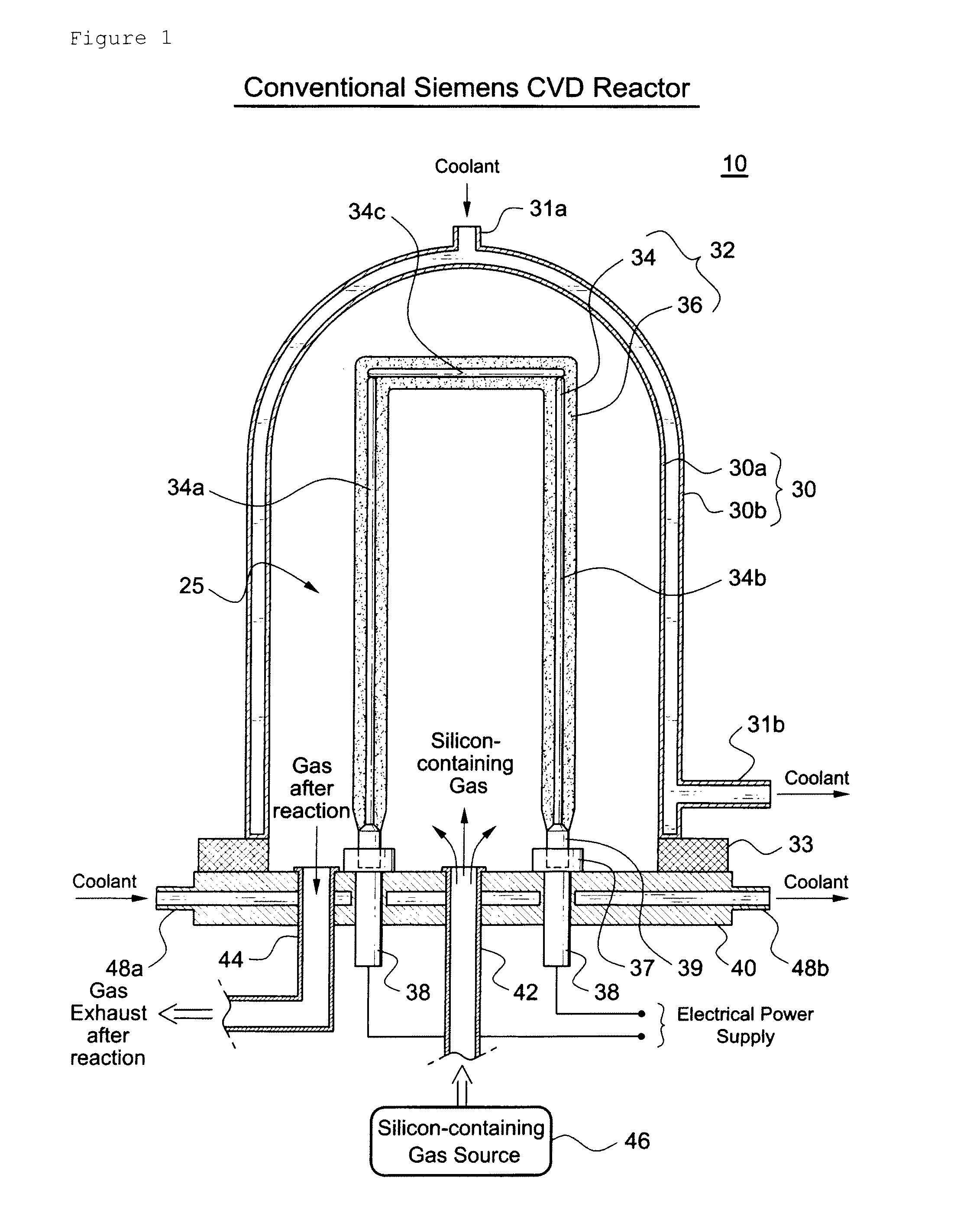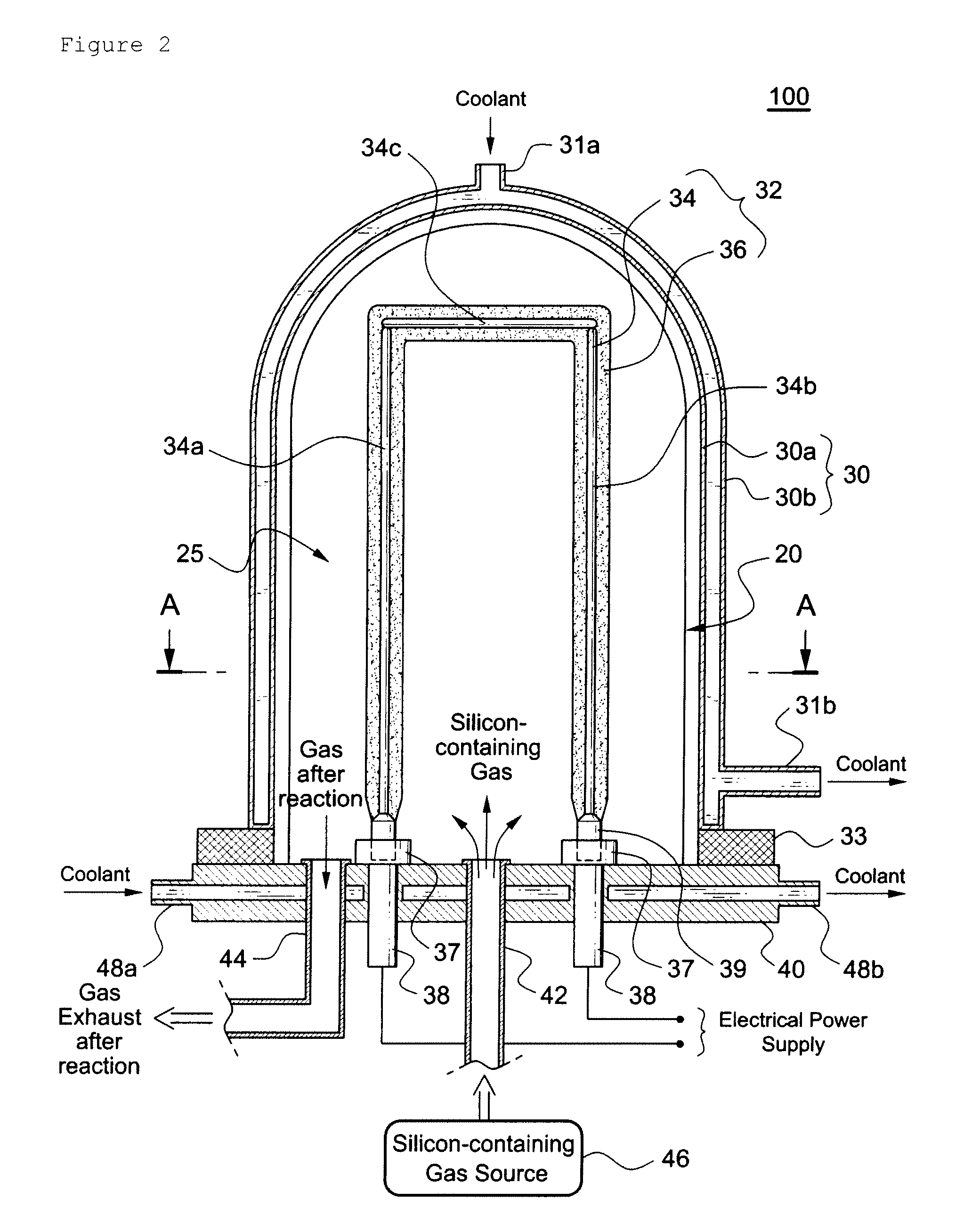CVD reactor with energy efficient thermal-radiation shield
- Summary
- Abstract
- Description
- Claims
- Application Information
AI Technical Summary
Benefits of technology
Problems solved by technology
Method used
Image
Examples
embodiment 1
[0085]A SiC-coated graphite thermal-radiation shield was placed between the heated rod filaments and the cooled wall of a Siemens CVD reactor. The 5 mm thick radiation shield covered the entire surface of the cooled wall but did not cover the surface of the base plate. The radiation shield was positioned with a 100 mm gap from the cooled wall. The spectral emissivity of the SiC coated graphite was considered to be 1.0. For a 115-mm diameter of polysilicon rod the total power consumption in the CVD reactor was 101 kW resulting in 24% electrical energy savings compared to the base-case. The polysilicon rod-core temperature was 1194° C. corresponding to a rod-core temperature decrease of 39° C. from the base-case.
embodiment 2
[0086]A perlite thermal-radiation shield was placed between the rod filaments and the cooled wall of a Siemens CVD reactor. The 100 mm thick radiation shield covered the entire surface of bell jar-shaped cooled wall, but did not cover the surface of the base plate. The radiation shield was positioned with a 5 mm gap from the cooled wall. The spectral emissivity of the perlite was considered to be 0.9 and the perlite thermal conductivity was 0.029 W / mK. For a 115 mm diameter of polysilicon rod, the total power consumption of the CVD reactor was 86 kW resulting in 35% electrical energy savings compared to the base-case. The polysilicon rod-core temperature was 1178° C. corresponding to a rod-core temperature decrease of 54° C. from the base-case.
embodiment 3
[0087]Three silicon thermal-radiation shields were placed between the rod filaments and the cooled wall of a Siemens CVD reactor. The silicon shields were configured as shown in FIG. 4. The 5 mm thick (ea) radiation shields covered the entire bell jar-shaped cooled wall, but did not cover the surface of the base plate. The radiation shields were positioned with a 5 mm gap from the cooled wall. The spectral emissivity of the silicon was considered to be 0.9. For a 115 mm diameter of polysilicon rod, the total power consumption of the CVD reactor was 52 kW resulting in 61% electrical energy savings compared to the base case. The polysilicon rod-core temperature was 1145° C. corresponding to a rod-core temperature decrease of 88° C. from the base-case.
[0088]The heat shield effects mentioned above, such as heat shield by virtue of high temperature emittance (>400° C.), heat shield by multiple layers of radiation shield, heat shield by low emissivity spectral emittance of shield material...
PUM
| Property | Measurement | Unit |
|---|---|---|
| Temperature | aaaaa | aaaaa |
| Power | aaaaa | aaaaa |
| Temperature | aaaaa | aaaaa |
Abstract
Description
Claims
Application Information
 Login to View More
Login to View More - R&D
- Intellectual Property
- Life Sciences
- Materials
- Tech Scout
- Unparalleled Data Quality
- Higher Quality Content
- 60% Fewer Hallucinations
Browse by: Latest US Patents, China's latest patents, Technical Efficacy Thesaurus, Application Domain, Technology Topic, Popular Technical Reports.
© 2025 PatSnap. All rights reserved.Legal|Privacy policy|Modern Slavery Act Transparency Statement|Sitemap|About US| Contact US: help@patsnap.com



